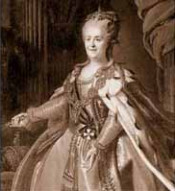
Discipline (Police) Regulations adopted by Catherine II
On April 8 (19), 1782 Catherine II of Russia approved the Discipline (Police) Regulations according to which was established a new municipal administrative and police authority – Discipline or police Department, special positions of employees of the city police were introduced, its functions and competence were refined.
The first police authorities of Russia appeared in the period of transformations by Peter I, but the creation of the relevant authorities concerned only St. Petersburg and Moscow. During the reign of Peter’s successors, the formation and further development of police bodies, their turning into a system not only central but also local authorities, had not received adequate attention. Problems emerging locally required solutions at the national level and could be solved by reforming the central and local government, creation of new units of the state apparatus, improvement of legislation.
During the reign of Catherine II, in the course of the local authorities reforms (1775-1785), was discussed the issue of police administration. From 1779 the development of the Discipline Regulations project began. It was completed in 1781. The main documents which served as sources for the Regulations were: Enactment on provinces, Ulozheniye Commissions, foreign police regulations and legal treatises. The idea was to create police agencies in the cities in order to protect order, peace and silence.
On April 8 (19), 1782 the Regulations were approved. The document comprised 274 clauses united into 14 units. It regulated the structure of police agencies, their system and main areas of activity; it also listed punishable acts.
It was the Discipline board that was charged with maintenance of ‘order, peace and silence’. The board included a chief of city police, a commandant or a governor, police officers for civil and criminal cases, elected merchant class representatives.
Discipline Department was subject to the provincial government and performed a variety of administrative and economic and judicial functions.
Every town numbering over 4000 farmsteads was divided into parts (200-700 farmsteads) which in their turn were divided into quarters (50-100 farmsteads). A privy police officer headed the police administration in the part of a town; a quarter was managed by a non-commissioned police officer.
The police observed morals and manners, entertainments, took measures for maintenance of people’s health, town economy, trade and supply of provisions. It suppressed riots, conducted preliminary investigation and search of criminals. The police was in charge of the acts concerning the break of laws and police decisions; opposing the orthodox church; breaking public order and rules of conduct (hard drinking, gambling, swearing, unauthorized building); crimes against individuals and property. Discipline regulation practically formed a new law area – police law.
Besides the organizational system of police administration the Regulations contained certain moral rules to be observed by police and civilians. More to that the document provided a portrait of an ideal public officer endowed with virtues and free of vices: he must demonstrate philanthropy, honest attitude to service, unselfishness; he had to administer honest justice, follow only the law and abstain from bribes because they ‘blind one’s eyes and corrupt one’s mind and heart’.
Local governance reforms undertaken in the reign of Catherine II enabled to make a certain system of the police authorities, although special cross-governorate governing body of the police at that time had not been created. After bourgeois reforms of 1860-1870s the discipline boards were no longer responsible for criminal cases and town beautification and by the end of the 19th century they were all abolished.
Lit.: Анучин Е. Н. Исторический обзор развития административно-полицейских учреждений в России, с Учреждения о губерниях 1775 г. до последнего времени. СПб., 1872; Павленко Н. И. Екатерина Великая М., 2006; Пинигин М. Г. Организационно-правовые основы деятельности полиции в России по «Уставу Благочиния или полицейскому», 1782-1862 гг.: Автореф. дис. … канд. юр. наук. М., 2003; Пинигин М. Г. «Устав благочиния» как источник российского полицейского права. Тюмень, 2004; Селиванов А. М. Служить Отечеству честь имею: Сборник документов по истории органов внутренних дел Ярославского края в конце 18 — начале 21 века / А. М. Селиванов. Ярославль, 2002.
Based on the Presidential Library’s materials:

